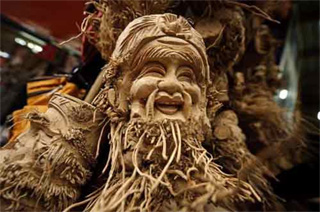News in Hoi An Ancient Town
Hoi An craftsman turns roots into souvenirs
Bamboo roots used to be burned as firewood in rural areas of Vietnam, since farmers only used trunks of bamboo trees for handcrafts or the building of houses.

However, craftsman Dinh Xuan Hung, 40, creates extraordinary bamboo root souvenirs for tourists in the ancient town of Hoi An.
Hung, who was born in the pottery village of Thanh Ha , started working in carpentry. Later, he learned that bamboo root creations could quickly make him prosperous.
He opened a store in an alley on Nguyen Thi Minh Khai Street , just a few steps behind the Japanese Bridge , where he displays all his works of bamboo roots and wooden statues.
"It's a chance for me. I started making my life in carpentry and wooden carvings 15 years ago, which I learnt from craftsmen in Kim Bong on the other side of the Thu Bon River ," Hung said.
"However, one day I picked up a bamboo root and looked at it curiously. I just created something for myself for fun, but it eventually took on features and a unique image. A cluster of bamboo roots looks like the long beard of an old man, so I sculpted the upper part to be the face of an elder," he said.
Hung remains the only craftsman making souvenirs from bamboo roots in Hoi An town, producing 1,000 souvenirs each year.
He explained that craftsmen could carve bamboo roots for sale in the tourism hubs, but it takes time and has little profit.
Huynh Suong, 46, an artisan from Kim Bong Village , said carvings with bamboo roots have become rare because of the poor materials available.
"It takes a long time searching for bamboo roots and a treatment process. Anyways, the locally made bamboo roots do not meet the standard of quarantine regulations, so foreign tourists could not take them home after their visits in Hoi An," Suong said, adding that this is the reason that so few craftsmen practice the carving of bamboo roots.
"Sometimes, craftsmen make them for fun, and the souvenirs are only bought by domestic tourists," he explained.
Usually, the process to carve bamboo roots into saleable keepsakes takes Hung nearly one month.
"I have to soak bamboo roots in water for 20 days before drying under the sunlight for three days. A two-hour carving and grinding will complete the process of a bamboo root-made souvenir, costing 200,000 VND (9.5 USD)," he explained.
As a craftsman, Hung said he will keep working with bamboo root as a fascinating art and an image of Hoi An town.
"I wish for the day when bamboo root souvenirs will become special gifts for visitors in Hoi An. The trade will help promote tourism in the city, as well create jobs for local people," Hung said.
Hung, who was born in the pottery village of Thanh Ha , started working in carpentry. Later, he learned that bamboo root creations could quickly make him prosperous.
He opened a store in an alley on Nguyen Thi Minh Khai Street , just a few steps behind the Japanese Bridge , where he displays all his works of bamboo roots and wooden statues.
"It's a chance for me. I started making my life in carpentry and wooden carvings 15 years ago, which I learnt from craftsmen in Kim Bong on the other side of the Thu Bon River ," Hung said.
"However, one day I picked up a bamboo root and looked at it curiously. I just created something for myself for fun, but it eventually took on features and a unique image. A cluster of bamboo roots looks like the long beard of an old man, so I sculpted the upper part to be the face of an elder," he said.
Hung remains the only craftsman making souvenirs from bamboo roots in Hoi An town, producing 1,000 souvenirs each year.
He explained that craftsmen could carve bamboo roots for sale in the tourism hubs, but it takes time and has little profit.
Huynh Suong, 46, an artisan from Kim Bong Village , said carvings with bamboo roots have become rare because of the poor materials available.
"It takes a long time searching for bamboo roots and a treatment process. Anyways, the locally made bamboo roots do not meet the standard of quarantine regulations, so foreign tourists could not take them home after their visits in Hoi An," Suong said, adding that this is the reason that so few craftsmen practice the carving of bamboo roots.
"Sometimes, craftsmen make them for fun, and the souvenirs are only bought by domestic tourists," he explained.
Usually, the process to carve bamboo roots into saleable keepsakes takes Hung nearly one month.
"I have to soak bamboo roots in water for 20 days before drying under the sunlight for three days. A two-hour carving and grinding will complete the process of a bamboo root-made souvenir, costing 200,000 VND (9.5 USD)," he explained.
As a craftsman, Hung said he will keep working with bamboo root as a fascinating art and an image of Hoi An town.
"I wish for the day when bamboo root souvenirs will become special gifts for visitors in Hoi An. The trade will help promote tourism in the city, as well create jobs for local people," Hung said.
Source Vietnam+
Related news
Copyright © 2016 RIVERSIDE OASIS VILLA All rights reserved.
.jpg)